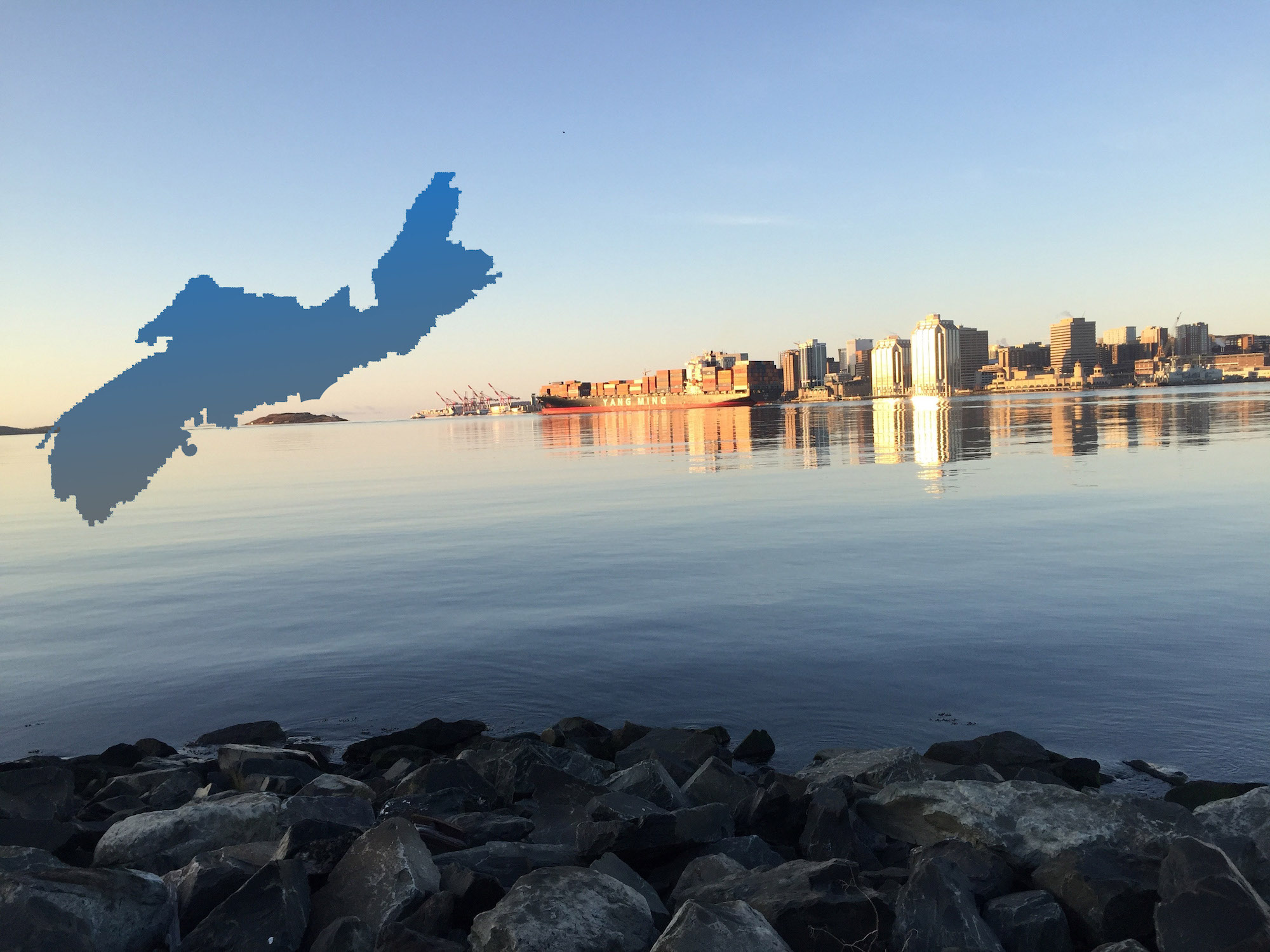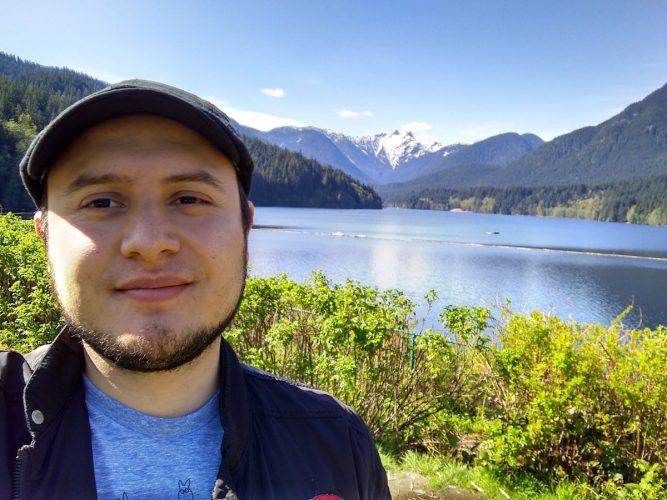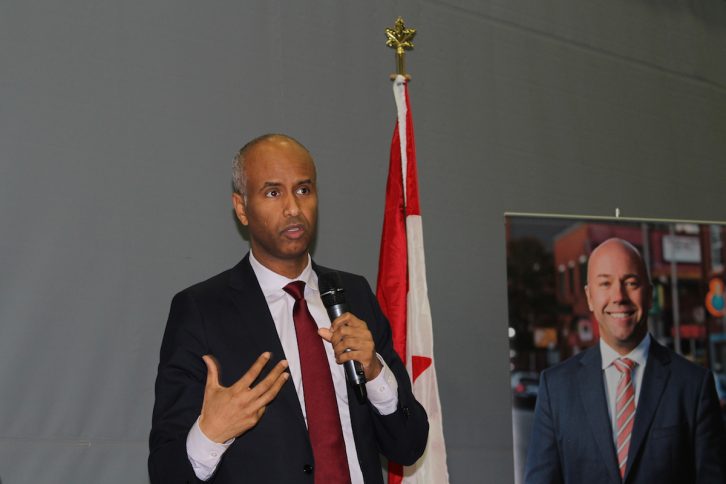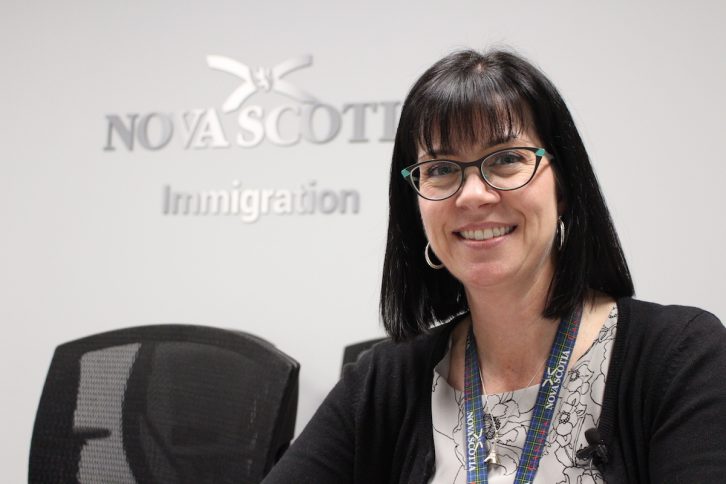Immigration
Stay or Leave? Immigrants in Nova Scotia answer the question

caption
Sunrise over Halifax, Nova Scotia. Montage map by Sofia Ortega. Photo credit: Sofia OrtegaMore immigrants coming to province, but many of them don't remain here
Editor's Note
This story was completed in fulfillment of requirements in the King's MJ program. Most reporting was completed between January and April 2018; the story has been updated to account for subsequent developments.
Deepa Mammen and Javan Monsivais are alike in many ways.
Both 27 years old, they came to Nova Scotia, from India and Mexico respectively, to work for different companies in the video game industry, one as programmer and the other as a software engineer.

caption
Deepa Mammen (left) and Javan Monsivais (right), two newcomers who came to Nova Scotia to work.Compilation by Sofia Ortega
Monsivais left the province for other opportunities, while Mammen decided to stay.
Nova Scotia is attracting more and more immigrants, like Mammen and Monsivais, but keeping them here remains a challenge, according to government data.
This is because population growth in the Atlantic region is slower than elsewhere in the country. It is mainly caused by lower natural population increases, higher inter-provincial migration and lower immigration levels.
Without skilled immigrants to fill vacant jobs as older employees retire, the provincial economy will suffer. Employers could leave and go elsewhere — or not come at all — if they cannot find workers they need.
Deepa Mammen hits Canada
Ontario receives the biggest proportion of immigrants. According to Statistics Canada, it received more than 37 per cent of the total permanent residents admitted in Canada in 2016.
Mammen arrived in Ontario in 2013, with the goal of pursuing a certificate degree in Computer Games and Programming Skills at Sheridan College.

caption
Deepa Mammen, a newcomer from India, said she has “no intentions of leaving here. I love this city.”She was excited and looking forward to making new friends in Ontario, but things didn’t go as expected.
“I couldn’t relate with a lot of things that Canadians here or people who grew up here could relate with, and so I really struggled a lot to have common grounds, things to talk about. Basically, it was much difficult than I thought,” she said.
Mammen met a few friends, but overall her year in Ontario wasn’t a very good experience. Even though her English language proficiency was good, she found others had a hard time understanding her.
“That kind of put me off, so I started just being quiet and (did) not communicate because I didn’t want to be misunderstood,” she said.
After completing the one-year program, Mammen started looking job opportunities around Canada. An independent game development studio based in Nova Scotia, Frontier Developments, hired her as a game programmer and in 2014 she moved to Halifax.
“Halifax was much nicer for me. When I first came to Halifax, it was love at first sight,” she said. “All its heritage buildings and it was so different and I loved it, the ocean and everything.”
Mammen made an active effort to be involved in her new community by volunteering with Feed Nova Scotia and Ronald McDonald House. Those experiences not only helped her build relationships with local people, but also learn what they talk about and how they interact with each other.
Since coming to Halifax, Mammen has worked for three different video game companies within the municipality.
“I don’t even think about moving from here; I really like Halifax. I’ve not visited a lot of cities in Canada, but … I’m pretty happy here,” she said. “I don´t see a reason why I should move.”
Mammen likes to be independent and do things on her own. She enjoys going on trails and hiking and exploring Halifax, but most part of her spare time goes to church. Little by little she has built connections, friendships and a home.
In 2016 Mammen received the permanent residence status and also decided to buy a house.
“Having a house makes me feel like I belong here. It makes me feel like an adult,” she said.
Mammen is happy with her decision to stay in Nova Scotia and, when asked about her any other goals she may have, answered with a smile.
“Just be and do what I’m doing with the best of my abilities and be better than the rest someday,” she said.
Javan Monsivais lands in Nova Scotia
At a young age Monsivais, was fascinated by video games and played them in his spare time. Eventually, this hobby became his career.

caption
Javan Monsivais is shown at Capitano Lake in Vancouver. “(Nova Scotia) is not a bad place, but I don’t think is a place for me,” he said.He studied software engineering and after completing his studies started working in the video game industry in different cities in Mexico. He soon realized there were a limited number of job opportunities; if he wanted to grow his career, he would have to move to somewhere where the industry is more developed.
Monsivais started applying for jobs in different countries. HB Studios, a Canadian video game developer company located in Lunenburg, answered his call.
With two bags full of clothes, spicy candies and an excitement to develop his passion and to explore his new home, Monsivais landed in Canada in the summer 2016.
“My first impression was it’s a really beautiful place; the weather was great at that time, but I thought this is really small. What I’m going to do here?,” he said. “That was just a thought.”
Monsivais enjoyed his job and his co-workers were nice and polite, but most of them were older than him, making it hard to make personal connections.
“I was feeling that professionally I was learning many things and progressing, but socially I was getting kind of stuck and I didn’t like that,” he said.
As the weeks passed, winter arrived.
“That’s when I started thinking about leaving because the weather was too extreme for me; it was really inconvenient. It was snowing all the time; I had to shovel the snow to go out to my job,” he said, while laughing.
Eventually, he decided to leave the snow behind and look for other opportunities.
In March 2017, Monsivais moved to Vancouver and started working at Capcom Game Studio as rendering and systems engineer.
“It has been one of the best years of my life,” he said. “Professionally my job is very fulfilling and Vancouver is never boring; it always surprises me.”
Even though the cost of living is higher in Vancouver than it is in Lunenburg, Monsivais lives comfortably and is enjoying both his personal and professional life.
“With the salary I got in my job, I can easily live here and do the things I like to do,” he said.
When asked if he missed Nova Scotia, Monsivais answered quickly.
“No. It’s not a bad place, but I don’t think is a place for me,” he said.
Population in Nova Scotia
Nova Scotia, along with the rest of the Atlantic provinces, faces population challenges.
Nova Scotia’s population of 55 years and over is larger than its population of children under 14 years. Since 2001 the number of people 55 years and over has increased, while the number of children under 14 years old has decreased, according to an analysis of census data from 2001 to 2016.
According to a paper by Ather Akbari, Chair of the Atlantic Research Group on Economics of Immigration, Aging and Diversity, economic effects of population decline and aging include labour shortages, shrinking markets for goods and services and “increased pressure on younger labour force participants to provide for the social programs for the elderly.”
Federal and provincial governments recognize immigration as both an important element to keep economy growing and to address Nova Scotia’s demographic challenge.
According to Statistics Canada, in 2016 the Atlantic provinces were home to 2.3 per cent of all the recent immigrants in Canada. While small, the proportion has doubled in the last 15 years.
Data from Immigration, Refugees and Citizenship Canada also shows that Nova Scotia is welcoming an increasing number of immigrants.
In 2016 the province admitted 5,485 permanent residents, a record number.
From those, 1,425 came under the resettled refugee and protected person category and most of them were part of the Syrian refugee influx. In 2017, 4,515 immigrants made Nova Scotia their home, most of them falling under an economic category.
The province has made active efforts to attract more immigrants. It invested in digital infrastructure for online applications to the Nova Scotia Nominee Program and increased the Provincial Nominee Program quota from 600 in 2013 to 1,350 in 2017.
Immigrants retention in Nova Scotia
According to a report by the Atlantic Provinces Economic Council released in January 2017, “while labour outcomes for economic immigrants are positive for those who choose to remain in the region, overall retention rates are low.”
The report shows that immigrants in the Atlantic region find jobs, but integration takes time.
Between 2011 and 2015, the average employment rate for immigrants landed five years or less was 66 per cent in Canada, while in Nova Scotia it was 69 per cent. The average employment rate for immigrants landed more than 10 years increased to 80 per cent nationally and to 84 per cent in Nova Scotia.
The report states “for economic principal applicant tax fillers, whether provincial nominees or federal skilled workers, only 64 per cent of those who land in the Atlantic provinces file taxes in the region one year later, and after five years the retention rate of Atlantic immigrant tax filers falls to 47 per cent.”
Specifically, for Nova Scotia, 75 per cent of those who land in the province file taxes here one year later. After five years that drops to 57 per cent.
In Alberta and Ontario for example, 95 per cent and 94 per cent respectively of those who land in there, file taxes in the province one year later. After five years that percentage drops to 89 per cent.
David Chaundy, Research Director of the Atlantic Provinces Economic Council, said that integration is a key to increasing retention.
“Although the focus has been on increasing the numbers, if we get a better match of individuals coming here that are more likely to stay, you don’t need to get as many because you’re going to hold on to them,” he said.
Chaundy said there’s a number of factors that impact retention, including how well are the immigrants integrate economically.
“One of the things we found in our previous research is we are not recruiting (just) one skilled worker,” he said.
“Generally, they are coming with a family and if the spouse is in an occupation where they are finding it hard to get their credentials recognized (or) if the family is not settled, or they just don’t like the climate or they just feel isolated, that worker is going to find it very hard to stay.”
The report points out the economic immigrant selection process “needs to balance immediate labour market needs, with other factors that contribute to long-term success and high retention, such as language proficiency and the capacity for a spouse to successfully integrate.”
Data from IRCC shows the average retention rate in the Atlantic provinces, for permanent residents who landed in the region between 2008 and 2013, was also among the lowest in the country.
Ahmad, from Malaysia to Halifax
Hidaya Ahmad was born in Kuala Lumpur 27 years ago.

caption
Hidaya Ahmad said she “moved to Toronto because I couldn´t find any jobs in Halifax.”Ahmad arrived in Halifax in 2012 to study neuroscience at Dalhousie University. She chose the area because the program she wanted to study wasn’t available in Malaysia and she wanted to be somewhere that wasn’t as populated.
“I wanted to experience (something that was) almost like the country side of Canada,” she said.
Ahmad describes her experience in the province as pleasant and exciting. She built relationships and made a lot of friends, both local and from other countries.
“I got to experience a lot of things that I could never have done or found in Malaysia. I met some Nova Scotians who thought me how to make a homemade jam out of daffodils,” she said with an amused tone.
In October 2015, Ahmad graduated with the goal of staying in the province to work.
“I was looking for research assistant jobs or administration jobs within hospitals, health-care administration jobs just to get my foot in the door and I couldn’t find any,” she said. “Most of them were union based; if we are talking of government hospitals … in general they’re union based; it’s really hard to break it to the market.”
Ahmed turned into Job Junction, a free service funded by Employment Nova Scotia, that supports individuals in their job search.
“I went to that for months and months and I saw myself improving, like I get some interest from people but then I was just networking for months and months,” she said. “It led to, sort of like, nothing.”
In May 2016, after more than six months of searching, she made a decision.
“I moved to Toronto because I couldn’t find any jobs in Halifax,” she said. “Not that I was picky or anything, (it was) just the lack of jobs, entry levels jobs that I would be over qualified for. Still there were no jobs in Halifax; they were not able to hire full-time or did not have the resources to hire.”
Ahmed said in Toronto she didn’t have to wait long to get hired. She currently works as a student recruitment advisor at an international network of higher education institutions.
“I’m doing well in education, it is not something that I really want to do, but is enough for now,” she said.
While she is glad to have found a job, Ahmed didn’t want to leave Halifax.
“I love the lifestyle in Halifax,” she said. “Actually, I love everything about Halifax.”
She left because she had to.
“Here people are always in a rush and the first thing that I noticed here is that sometimes when people talk to you … but they are looking at their phone,” she said. “They’re looking at the phone while they’re talking to you, but in Halifax people actually take time, sit down and to talk to you while looking at you in the eyes.”
Ahmed is now focused on her job and has plans to complete a master’s degree.
Atlantic Pilot Program
As of March 2017, Immigration, Refugees and Citizenship Canada started accepting permanent resident applications through the Atlantic Pilot Program.
Unlike other initiatives, employers are not required to obtain a labour market impact assessment for jobs offered within the pilot program.
On Feb. 21, Ahmed Hussen, Minister of Immigration Refugges and Citizenship, visited Halifax for an immigration and diversity town hall at the YMCA on Gottingen Street.
Hussen is an immigrant himself, having arrived in Canada as a Somalian refugee at the age of 16.
When asked about what they were doing to address the retention challenge in the province, Hussen pointed to the Atlantic Pilot Program, despite the fact it’s only recruited one quarter of the immigrants officials had aimed for.

caption
Minister of Immigration Ahmed Hussen speaks during a town hall in Halifax on Feb. 21“It’s a permanent worker program so in exchange for giving a break to employers for the labour market impact assessment in return we want them to help that newcomer skilled worker and their family to settle better by putting together a settlement plan with the settlement agencies,” he said.
“That addresses the retention question, also engaging employers and settlement agencies, engaging the provinces and the federal government to make sure we all work towards that retention piece.”
In 2017, the goal was to bring 2,000 new immigrants to the Atlantic region through the pilot program. Nova Scotia got 792 spots, but only 201 were filled.
Nova Scotia’s goal for 2018 is also 792. As of August 15, 529 endorsements had been issued.
Shelley Bent, Director of Programs in the Nova Scotia Office of Immigration, noted that the pilot didn’t launch until mid-March.
“There were some growing pains associated with launching a new program that it was later on that we started having more activity and uptake from employers,” she said. “You have to socialize what the program is and how do you apply what other rules around, looking for international talent and then recruiting them and bring them here.”
Bent said that the biggest challenge with the pilot program was many employers didn’t know that immigration was on option for them.
The Nova Scotia Office of Immigration has signed agreements with three community partners: Halifax Partnership, Cape Breton Partnership and the Western Regional Enterprise Network. They’ll introduce the Atlantic Pilot Program by speaking to employers about how they can use immigration to fill their labour gaps.
“We are confident that we will be able to exceed the numbers from last year,” Bent said.

caption
Shelley Bent is the Director of Programs at the Nova Scotia Office of Immigration.Lee Cohen, an immigration lawyer with more than 30 years of experience, said the Atlantic Pilot Program has a big flaw.
“There’s no mechanism by which people interested in working for Nova Scotian companies and Nova Scotian companies interested in hiring foreign nationals have a chance to meet each other,” he said.
Bent said that the Atlantic Pilot Program is an employer-driven program, “so the employer is the one who is seeking the foreign national to work for them.”
The names of designated companies are not public.
Nova Scotia immigration programs
Immigration is a shared jurisdiction between the province and the federal government.
There are six streams under the Provincial Nominee Program: the skilled worker, Nova Scotia demand express entry, Nova Scotia experience express entry, international graduate entrepreneur, entrepreneur and the physician stream. The physician stream is a new addition, created in February 2018 to attract international doctors.
Under the Atlantic Pilot Program there are three streams: high skilled, intermediate skilled and international graduates.
According to data from IRCC, most permanent residents admissions are economic immigrants.
“I think that we have an immigration program that is not sufficiently visionary and exciting enough to attract enough people,” Cohen said.
For him, the future of immigration for Canada and for Nova Scotia, should focus on the decentralization of deciding who gets in.
Cohen said it is important to attract people to various parts of Nova Scotia, including the rural areas. For him, a decentralized system would allow people from those rural areas to choose immigrants that fit their needs.

caption
Lee Cohen, immigration lawyer at his office in Halifax, said “I think that we have an immigration program that is not sufficiently visionary and exciting enough to attract enough people.”“I’ve always believed that the people who live in those areas are better equipped to determine what those areas need in terms of an immigration program and who should get in,” he said.
According to a survey from the Nova Scotia Office of Immigration to evaluate the Provincial Nominee Program from 2012 to 2017, more than 55 per cent of the nominees who answered the survey (2,225), first settled in Halifax after arriving in Nova Scotia.
“On many occasions I have believed that the biggest obstruction to successful immigration to Canada is the immigration system itself,” said Cohen.
Jobs and a welcoming community is what it takes
“When the people get here, they realize it’s small: small geographically, small economically, the workforce is small, and the mindset of the people is still small; that’s not our fault. We are small, but we have to think big,” said Cohen.
For John Shields, professor of politics and public administration at Ryerson University, “a very important part of this is a welcoming community.”
“So newcomers, when they arrive, they want to feel that they going to be able to fit into their new society. Also, of course, a big part of integration is finding employment opportunities,” said Shields.
But this is not always the case.
In February 2014, the Nova Scotia Commission on Building Our New Economy released the Now or Never report which said Nova Scotians seem to be positive about newcomers from other parts of Canada, but are somewhat “less welcoming to immigrants.”
Immigrant Services Association of Nova Scotia’s Nabiha Atallah said residents must be willing to change, if they want immigrants to stay.
“Nova Scotians are becoming more open to immigrants and more welcoming, but I think (it) is not easy, is not a place with a lot of immigrants compared with other parts of Canada,” she said. “There aren’t big ethnic communities, so that means there’s less support for the immigrant but also less general comfort in the society with immigrants.”
According to Statistics Canada data from 2011 to 2016, most of the recent immigrants in Nova Scotia are from the Philippines, United Kingdom, China, India and Syria.
“The first thing than an immigrant needs here is a job, that’s a no brainer,” said Roberto Montiel, the coordinator of the Halifax Local Immigration Partnership. LIP, in partnership with other groups, helps newcomers get settled when they arrive in Halifax.
“But there are many factors participating in them finding meaningful employment, employment that relates to their backgrounds.”
Abid Raza: loves Halifax, but also his career.
Twenty-nine-year-old Abid Raza is from Karachi, the major commercial and industrial centre of Pakistan. He came to Nova Scotia in 2014 to pursue a Masters of Engineering in Internetworking at Dalhousie University.

caption
Abid Raza often wonders if he misses Halifax: “I keep telling my colleagues that if they were telling me one day how about you move back to Halifax, I’d pack up my stuff and move right away.”Raza describes himself as a very social person who enjoys meeting new people and making friends from different cultures and backgrounds. During his time as a student he managed to balance school, part-time jobs and leisure activities.
“My experience was amazing, I love Halifax as a city. I confidently say that I easily settled here,” he said.
With previous work experience in the telecommunication industry, Raza’s goal when he entered his program was clear.
“(It was) to work on the local industry of the program I just graduated from,” he said.
Raza graduated in May 2016 and soon after landed a job as senior network consultant at NTT DATA Corporation, an IT services provider.
He worked there for about a year and a half. However, after a few months he was notified that the project he was working would end within a few months, so he would need to start looking for another job. He wanted to stay in Halifax, but said there were no job opportunities in his field.
“Even though there’re jobs in IT, IT is not the same as networking engineering,” he said. “Network is specific and if you are looking for a senior network consultancy position or a more challenging job, then is hard to find.”
After four months of looking for other positions, Raza finally got a job in New Brunswick as a technical consultant at Bell. He has been working there since September 2017.
Even though Raza is happy to have a job in his field, he hasn’t enjoyed living in New Brunswick.
“I don’t believe that New Brunswick is a place for a single or bachelor person,” he said. “There’s not much to do there; (this) is the first time in my life that I bought a TV.”
Raza said he believes a person’s life outside of the office impacts their life at the office, specifically their thinking and work performance.
“Do I miss Halifax? I keep telling my colleagues that if they were telling me one day how about you move back to Halifax, I’d pack up my stuff and move right away,” he said.
A long way to go
Ather Akbari, Chair of the Atlantic Research Group on Economics of Immigration, Aging and Diversity, said the government is doing a lot to improve immigration in the province, but much more is needed.
“There is not much that policy can do to create separated opportunities for immigrants,” he said. “The employers attitude would have to change in that regard so that they view immigrants in the same way as they view a Canadian-born.”
To do this, he said, people need to look beyond stereotypes.
“Is not that they are taking off the jobs from locals. Immigrants who come in especially under the PNP program are brought in because no one is available locally and there is a need.”

